A Model for Estimating Dose-Rate Effects on Cell-Killing of Human Melanoma after Boron Neutron Capture Therapy
Abstract
1. Introduction
2. Materials and Methods
2.1. Calculation of Microdosimetric Quantities
2.2. Model Overview
2.2.1. Improvement of the IMK Model to Consider Changes in 10B Concentrations
- A first-order process by which a PLL may transform into an LL at a constant rate of a in h−1;
- A second-order process by which two PLLs may interact and transform into an LL at a constant rate of bd in h−1;
- A first-order process by which a PLL may be repaired at a constant rate of c in h−1.
2.2.2. Integrated Microdosimetric-Kinetic Model for a Constant Dose-Rate
2.3. Determination of Model Parameters for Human Melanoma
2.4. Mean Inactivation Dose and Relative Biological Effectiveness
3. Results and Discussion
3.1. Comparison between In Vitro Experimental Data and Corresponding Model Predictions
3.2. Dependence of 10B Concentration in Tumor Cells on Biological Effects
3.3. Dose-Rate Effects under BNCT Irradiations
3.4. Estimation of Dose–Response Curve Considering the Dynamics of BPA Concentrations
4. Conclusions
Author Contributions
Funding
Conflicts of Interest
References
- Joiner, M.C.; Van Der Kogel, A.J.; Steel, G.G. Introduction: The significance of radiobiology and radiotherapy for cancer treatment. In Basic Clinical Radiobiology, 4th ed.; Joiner, M.C., van der Kogel, A., Eds.; Edward Arnold: London, UK, 2018; pp. 1–10. [Google Scholar]
- Shirato, H.; Shimizu, S.; Kunieda, T.; Kitamura, K.; Van Herk, M.; Kagei, K.; Nishioka, T.; Hashimoto, S.; Fujita, K.; Aoyama, H.; et al. Physical aspects of a real-time tumor-tracking system for gated radiotherapy. Int. J. Radiat. Oncol. 2000, 48, 1187–1195. [Google Scholar] [CrossRef]
- Kuperman, V.; Ventura, A.M.; Sommerfeldt, M. Effect of radiation protraction in intensity-modulated radiation therapy with direct aperture optimization: A phantom study. Phys. Med. Boil. 2008, 53, 3279–3292. [Google Scholar] [CrossRef] [PubMed]
- Hosmane, N.S.; Maguire, J.A.; Zhu, Y.; Takagaki, M. What is cancer: Radiation Therapy. In Boron and Gadolinium Neutron Capture Therapy for Cancer Treatment; Hosmane, N.S., Eagling, R., Eds.; World Scientific: Singapore, 2018; pp. 101–143. [Google Scholar]
- Takagaki, M.; Kazuko, U.; Hosmane, N.S. Chapter 5: An Overview of Clinical and Biological Aspects of Current Boron Neutron Capture Therapy (BNCT) for Cancer Treatment. In Handbook of Boron Science with Applications in Organometallics, Catalysis, Materials and Medicine Volume 4: Boron in Medicine; Hosmane, N.S., Maguire, J.A., Zhu, Y., Takagaki, M., Eds.; World Scientific: Singapore, 2012; pp. 21–23. [Google Scholar]
- Inaniwa, T.; Suzuki, M.; Furukawa, T.; Kase, Y.; Kanematsu, N.; Shirai, T.; Hawkins, R.B. Effects of Dose-Delivery Time Structure on Biological Effectiveness for Therapeutic Carbon-Ion Beams Evaluated with Microdosimetric Kinetic Model. Radiat. Res. 2013, 180, 44–59. [Google Scholar] [CrossRef] [PubMed]
- Kishan, A.U.; Lee, P. MRI-guided radiotherapy: Opening our eyes to the future. Integr. Cancer Sci. Ther. 2016, 3, 420–427. [Google Scholar] [CrossRef]
- Locher, G.L. Biological effects and therapeutic possibilities of neutrons. Am. J. Roentgenol. 1936, 36, 1–13. [Google Scholar]
- Coderre, J.A.; Makar, M.S.; Micca, P.L.; Nawrocky, M.M.; Liu, H.B.; Joel, D.D.; Slatkin, D.N.; Amols, H.I. Derivations of relative biological effectiveness for the high-let radiations produced during boron neutron capture irradiations of the 9l rat gliosarcoma in vitro and in vivo. Int. J. Radiat. Oncol. 1993, 27, 1121–1129. [Google Scholar] [CrossRef]
- Suzuki, M. Boron neutron capture therapy (BNCT): A unique role in radiotherapy with a view to entering the accelerator-based BNCT era. Int. J. Clin. Oncol. 2020, 25, 43–50. [Google Scholar] [CrossRef]
- Hopewell, J.W.; Morris, G.M.; Schwint, A.E.; Coderre, J.A. Neutron Capture Therapy, Principles and Applications. In Boron Neutron Capture Therapy: Application of Radiobiological Principles; Sauerwein, W.A.G., Wittig, A., Moss, R., Nakagawa, Y., Eds.; Springer: Berlin/Heidelberg, Germany, 2012; pp. 329–358. [Google Scholar]
- Misihma, Y. Neutron capture treatment of malignant melanoma using 10B-chlorpromazine. Pigment Cell Res. 1973, 1, 215–221. [Google Scholar]
- Mishima, Y.; Honda, C.; Ichihashi, M.; Obara, H.; Hiratsuka, J.; Fukuda, H.; Karashima, H.; Kobayashi, T.; Kanda, K.; Yoshino, K.; et al. Treatment of malignant melanoma by single thermal neutron capture therapy with melanoma-seeking 10B-compound. Lancet 1989, 12, 383–389. [Google Scholar] [CrossRef]
- Yoshino, K.; Suzuki, A.; Mori, Y.; Kakihana, H.; Honda, C.; Mishima, Y.; Kobayashi, T.; Kanda, K. Improvement of solubility of p-boronophenylalanine by complex formation with monosaccharides. Strahlenther. Onkol. 1989, 165, 127–129. [Google Scholar]
- Joiner, M.C. Quantifying cell kill and cell survival. In Basic Clinical Radiobiology, 4th ed.; Joiner, M.C., van der Kogel, A., Eds.; Edward Arnold: London, UK, 2009; pp. 41–55. [Google Scholar]
- Bentzen, S.; Joiner, M.; Van Der Kogel, A. The linear-quadratic approach in clinical practice. In Basic Clinical Radiobiology, 4th ed.; Joiner, M.C., van der Kogel, A., Eds.; Edward Arnold: London, UK, 2009; pp. 120–134. [Google Scholar]
- McMahon, S.J. The linear quadratic model: Usage, interpretation and challenges. Phys. Med. Boil. 2018, 64, 01TR01. [Google Scholar] [CrossRef] [PubMed]
- Hawkins, R.B. A Statistical Theory of Cell Killing by Radiation of Varying Linear Energy Transfer. Radiat. Res. 1994, 140, 366. [Google Scholar] [CrossRef] [PubMed]
- Hawkins, R.B. A microdosimetric-kinetic model of cell death from exposure to ionizing radiation of any LET, with experimental and clinical applications. Int. J. Radiat. Boil. 1996, 69, 739–755. [Google Scholar] [CrossRef] [PubMed]
- ICRU. Microdosimetry; Report 36; International Commission on Radiation Units and Measurements: Rockville, MD, USA, 1983. [Google Scholar]
- Kase, Y.; Kanai, T.; Matsumoto, Y.; Furusawa, Y.; Okamoto, H.; Asaba, T.; Sakama, M.; Shinoda, H. Microdosimetric Measurements and Estimation of Human Cell Survival for Heavy-Ion Beams. Radiat. Res. 2006, 166, 629–638. [Google Scholar] [CrossRef]
- Okamoto, H.; Kanai, T.; Kase, Y.; Matsumoto, Y.; Furusawa, Y.; Fujita, Y.; Saitoh, H.; Itami, J.; Kohno, T. Relation between lineal energy distribution and relative biological effectiveness for photon beams according to the microdosimetric kinetic model. J. Radiat. Res. 2010, 52, 75–81. [Google Scholar] [CrossRef]
- Sato, T.; Furusawa, Y. Cell survival fraction estimation based on the probability densities of domain and cell nucleus specific energies using improved microdosimetric kinetic models. Radiat. Res. 2012, 178, 341–356. [Google Scholar] [CrossRef]
- Kase, Y.; Yamashita, W.; Matsufuji, N.; Takada, K.; Sakae, T.; Furusawa, Y.; Yamashita, H.; Murayama, S. Microdosimetric calculation of relative biological effectiveness for design of therapeutic proton beams. J. Radiat. Res. 2012, 54, 485–493. [Google Scholar] [CrossRef]
- Horiguchi, H.; Sato, T.; Kumada, H.; Yamamoto, T.; Sakae, T. Estimation of relative biological effectiveness for boron neutron capture therapy using the PHITS code coupled with a microdosimetric kinetic model. J. Radiat. Res. 2014, 56, 382–390. [Google Scholar] [CrossRef]
- Sato, T.; Masunaga, S.-I.; Kumada, H.; Hamada, N. Microdosimetric Modeling of Biological Effectiveness for Boron Neutron Capture Therapy Considering Intra- and Intercellular Heterogeneity in 10B Distribution. Sci. Rep. 2018, 8, 988. [Google Scholar] [CrossRef]
- Sato, T.; Kase, Y.; Watanabe, R.; Niita, K.; Sihver, L. Biological Dose Estimation for Charged-Particle Therapy Using an Improved PHITS Code Coupled with a Microdosimetric Kinetic Model. Radiat. Res. 2009, 171, 107–117. [Google Scholar] [CrossRef]
- Sato, T.; Iwamoto, Y.; Hashimoto, S.; Ogawa, T.; Furuta, T.; Abe, S.-I.; Kai, T.; Tsai, P.-E.; Matsuda, N.; Iwase, H.; et al. Features of Particle and Heavy Ion Transport code System (PHITS) version 3.02. J. Nucl. Sci. Technol. 2018, 55, 684–690. [Google Scholar] [CrossRef]
- Elkind, M.M.; Sutton, H. Radiation Response of Mammalian Cells Grown in Culture: I. Repair of X-Ray Damage in Surviving Chinese Hamster Cells. Radiat. Res. 1960, 13, 556. [Google Scholar] [CrossRef] [PubMed]
- Elkind, M.M. Repair Processes in Radiation Biology. Radiat. Res. 1984, 100, 425. [Google Scholar] [CrossRef] [PubMed]
- Matsuya, Y.; Kimura, T.; Date, H. Markov chain Monte Carlo analysis for the selection of a cell-killing model under high-dose-rate irradiation. Med Phys. 2017, 44, 5522–5532. [Google Scholar] [CrossRef] [PubMed]
- McGarry, C.K.; Butterworth, K.T.; Trainor, C. Temporal characterization and in vitro comparison of cell survival following the delivery of 3D conformal, intensity-modulated radiation therapy (IMRT) and volumetric modulated arc therapy (VMAT). Phys. Med. Biol. 2011, 56, 2445–2457. [Google Scholar] [CrossRef] [PubMed]
- Matsuya, Y.; McMahon, S.J.; Tsutsumi, K.; Sasaki, K.; Okuyama, G.; Yoshii, Y.; Mori, R.; Oikawa, J.; Prise, K.M.; Date, H. Investigation of dose-rate effects and cell-cycle distribution under protracted exposure to ionizing radiation for various dose-rates. Sci. Rep. 2018, 8, 8287. [Google Scholar] [CrossRef] [PubMed]
- Matsuya, Y.; McMahon, S.J.; Ghita, M.; Yoshii, Y.; Sato, T.; Date, H.; Prise, K.M. Intensity Modulated Radiation Fields Induce Protective Effects and Reduce Importance of Dose-Rate Effects. Sci. Rep. 2019, 9, 9483. [Google Scholar] [CrossRef]
- Matsuya, Y.; Sasaki, K.; Yoshii, Y.; Okuyama, G.; Date, H. Integrated Modelling of Cell Responses after Irradiation for DNA-Targeted Effects and Non-Targeted Effects. Sci. Rep. 2018, 8, 4849. [Google Scholar] [CrossRef]
- Saga, R.; Matsuya, Y.; Takahashi, R.; Hasegawa, K.; Date, H.; Hosokawa, Y. Analysis of the high-dose-range radioresistance of prostate cancer cells, including cancer stem cells, based on a stochastic model. J. Radiat. Res. 2019, 60, 298–307. [Google Scholar] [CrossRef]
- Hirayama, H.; Namito, Y.; Bielajew, A.F.; Wilderman, S.J.; Nelson, W.R. The EGS5 Code System; Office of Scientific and Technical Information (OSTI): Oak Ridge, TN, USA, 2005. [Google Scholar]
- Iwamoto, Y.; Niita, K.; Sato, T.; Matsuda, N.; Iwase, H.; Nakashima, H.; Sakamoto, Y. Application and Validation of Event Generator in the PHITS Code for the Low-Energy Neutron-Induced Reactions. Prog. Nucl. Sci. Technol. 2011, 2, 931–935. [Google Scholar] [CrossRef]
- Rossini, A.E.; Dagrosa, M.A.; Portu, A.; Martin, G.S.; Thorp, S.; Casal, M.; Navarro, A.; Juvenal, G.; Pisarev, M.A. Assessment of biological effectiveness of boron neutron capture therapy in primary and metastatic melanoma cell lines. Int. J. Radiat. Boil. 2014, 91, 81–89. [Google Scholar] [CrossRef] [PubMed]
- Ceballos, C.; Esposito, J.; Agosteo, S.; Colautti, P.; Conte, V.; Moro, D.; Pola, A. Towards the final BSA modeling for the accelerator-driven BNCT facility at INFN LNL. Appl. Radiat. Isot. 2011, 69, 1660–1663. [Google Scholar] [CrossRef] [PubMed]
- Hawkins, R.B.; Inaniwa, T. A Microdosimetric-Kinetic Model for Cell Killing by Protracted Continuous Irradiation Including Dependence on LET I: Repair in Cultured Mammalian Cells. Radiat. Res. 2013, 180, 584–594. [Google Scholar] [CrossRef] [PubMed]
- Brenner, D.J. The Linear-Quadratic Model Is an Appropriate Methodology for Determining Isoeffective Doses at Large Doses Per Fraction. Semin. Radiat. Oncol. 2008, 18, 234–239. [Google Scholar] [CrossRef] [PubMed]
- Chib, S.; Greenberg, E. Understanding the Metropolis-Hastings Algorithm. Amer. Statist. 1995, 49, 327–335. [Google Scholar]
- Gelfand, A.E.; Smith, A.F.M. Sampling-based approaches to calculating marginal density. J. Am. Stat. Assoc. 1990, 85, 398–409. [Google Scholar] [CrossRef]
- Stephens, T.C.; Eady, J.J.; Peacock, J.H.; Steel, G.G. Split-dose and Low Dose-rate Recovery in Four Experimental Tumour Systems. Int. J. Radiat. Boil. Relat. Stud. Phys. Chem. Med. 1987, 52, 157–170. [Google Scholar] [CrossRef]
- ICRU. Quantitative Concepts and Dosimetry in Radobiology; Report No. 30; International Commission on Radiation Units and Measurements: Washington, DC, USA, 1979. [Google Scholar]
- Olive, P.L. The role of DNA single- and double-strand breaks in cell killing by ionizing radiation. Radiat. Res. 1998, 150, S42. [Google Scholar] [CrossRef]
- Dizdaroglu, M.; Jaruga, P. Mechanisms of free radical-induced damage to DNA. Free. Radic. Res. 2012, 46, 382–419. [Google Scholar] [CrossRef]
- Goodhead, D. Initial Events in the Cellular Effects of Ionizing Radiations: Clustered Damage in DNA. Int. J. Radiat. Boil. 1994, 65, 7–17. [Google Scholar] [CrossRef]
- Carante, M.P.; Altieri, S.; Bortolussi, S.; Postuma, I.; Protti, N.; Ballarini, F. Modeling radiation-induced cell death: Role of different levels of DNA damage clustering. Radiat. Environ. Biophys. 2015, 54, 305–316. [Google Scholar] [CrossRef] [PubMed]
- Cirrone, G.P.; Manti, L.; Margarone, D.; Petringa, G.; Giuffrida, L.; Minopoli, A.; Picciotto, A.; Russo, G.; Cammarata, F.; Pisciotta, P.; et al. First experimental proof of Proton Boron Capture Therapy (PBCT) to enhance proton therapy effectiveness. Sci. Rep. 2018, 8, 1141. [Google Scholar] [CrossRef] [PubMed]
- Tabbakh, F.; Hosmane, N.S. Enhancement of Radiation Effectiveness in Proton Therapy: Comparison Between Fusion and Fission Methods and Further Approaches. Sci. Rep. 2020, 10, 5466. [Google Scholar] [CrossRef] [PubMed]
- Hiratsuka, J.; Fukuda, H.; Kobayashi, T.; Karashima, H.; Yoshino, K.; Imajo, Y.; Mishima, Y. The Relative Effectiveness of ’OB-Neutron Biological Capture Therapy for Early Skin Reaction in the Hamster. Radiat. Res. 1991, 128, 186–191. [Google Scholar] [CrossRef] [PubMed]
- Coderre, J.A.; Makar, M.S. Riobiology of Boron Neutron Capture Therapy: Program with the Concept of Relative Biological Effectiveness. In Progress in Neutron Capture Therapy for Cancer; Springer: Boston, MA, USA, 1992; pp. 435–437. [Google Scholar]
- Kinashi, Y.; Takahashi, S.; Kashino, G.; Okayasu, R.; Masunaga, S.-I.; Suzuki, M.; Ono, K. DNA double-strand break induction in Ku80-deficient CHO cells following Boron Neutron Capture Reaction. Radiat. Oncol. 2011, 6, 106. [Google Scholar] [CrossRef] [PubMed]
- Stephens, T.C.; Peacock, J.H.; Shipley, W.U.; Steel, G.G. Response to continuous irradiation (CI) in relation to the initial slope of the cell survival curve for tumours and bone marrow. Br. J. cancer. Suppl. 1984, 6, 271–274. [Google Scholar]
- Kinashi, Y.; Okumura, K.; Kubota, Y.; Kitajima, E.; Okayasu, R.; Ono, K.; Takahashi, S. Dose-rate effect was observed in T98G glioma cells following BNCT. Appl. Radiat. Isot. 2014, 88, 81–85. [Google Scholar] [CrossRef]
- Metting, N.F.; Brab, L.A.; Roesch, W.C. Dose-rate evidence for two kinds of radiation damage in stationary-phase mamma- lian cells. Radiat. Res. 1985, 103, 204–218. [Google Scholar] [CrossRef]
- Amundson, S.A.; Chen, D.J. Inverse dose-rate effect for mutation induction by γ-rays in human lymphoblasts. Int. J. Radiat. Biol. 1996, 69, 555–563. [Google Scholar] [CrossRef]
- Stevens, D.L.; Bradley, S.; Goodhead, D.T.; Hill, M.A. The Influence of Dose Rate on the Induction of Chromosome Aberrations and Gene Mutation after Exposure of Plateau Phase V79-4 Cells with High-LET Alpha Particles. Radiat. Res. 2014, 182, 331–337. [Google Scholar] [CrossRef]
- Mitchell, C.R.; Folkard, M.; Joiner, M.C. Effects of exposure to low-dose-rate 60Co gamma rays on human tumor cells in vitro. Radiat. Res. 2002, 158, 311–318. [Google Scholar] [CrossRef]
- Dillehay, L.E. A Model of Cell Killing by Low-Dose-Rate Radiation Including Repair of Sub lethal Damage, G2 Block, and Cell Division. Radiat. Res. 1990, 124, 201–207. [Google Scholar] [CrossRef] [PubMed]
- Wuu, C.S.; Zaider, M. A Mathematical Description of Sublethal Damage Repair and Interaction During Low Dose-Rate Irradiation. Radiat. Prot. Dosim. 1994, 52, 211–215. [Google Scholar] [CrossRef]
- Marples, B.; Wouters, B.; Collis, S.; Chalmers, A.J.; Joiner, M.C. Low-Dose Hyper-radiosensitivity: A Consequence of Ineffective Cell Cycle Arrest of Radiation-Damaged G2-Phase Cells. Radiat. Res. 2004, 161, 247–255. [Google Scholar] [CrossRef] [PubMed]
- Joiner, M.C.; Marples, B.; Lambin, P.; Short, S.C.; Turesson, I. Low-dose hypersensitivity: Current status and possible mechanisms. Int. J. Radiat. Oncol. 2001, 49, 379–389. [Google Scholar] [CrossRef]
- Short, S.C. Low-dose hypersensitivity after fractionated low-dose irradiation in vitro. Int. J. Radiat. Boil. 2001, 77, 655–664. [Google Scholar] [CrossRef]
- Chen, Y.; Li, J.; Li, C.; Qiu, R.; Wu, Z. A modified microdosimetric kinetic model for relative biological effectiveness calculation. Phys. Med. Boil. 2017, 63, 015008. [Google Scholar] [CrossRef]
- Matsuya, Y.; Ohtsubo, Y.; Tsutsumi, K.; Sasaki, K.; Yamazaki, R.; Date, H. Quantitative estimation of DNA damage by photon irradiation based on the microdosimetric-kinetic model. J. Radiat. Res. 2014, 55, 484–493. [Google Scholar] [CrossRef]
- Nikjoo, H.; Emfietzoglou, D.; Liamsuwan, T.; Taleei, R.; Liljequist, D.; Uehara, S. Radiation track, DNA damage and response—A review. Rep. Prog. Phys. 2016, 79, 116601. [Google Scholar] [CrossRef]
- Matsuya, Y.; Kai, T.; Yoshii, Y.; Yachi, Y.; Naijo, S.; Date, H.; Sato, T. Modeling of yield estimation for DNA strand breaks based on Monte Carlo simulations of electron track structure in liquid water. J. Appl. Phys. 2019, 126, 124701. [Google Scholar] [CrossRef]
- Morita, N. Marked Low Skin Reaction of Boron Neutron Capture Therapy in Melanoma-Bearing Hamsters in Comparison with a Single-Dose Electron Beam at a Tumor Control Dose. Kawasaki Med. J. 2004, 30, 9–17. [Google Scholar]
- Fukuda, H.; Hiratsuka, J.; Honda, C.; Kobayashi, T.; Yoshino, K.; Karashima, H.; Takahashi, J.; Abe, Y.; Kanda, K.; Ichihashi, M. Boron Neutron Capture Therapy of Malignant Melanoma Using 10B-Paraboronophenylalanine with Special Reference to Evaluation of Radiation Dose and Damage to the Normal Skin. Radiat. Res. 1994, 138, 435–442. [Google Scholar] [CrossRef] [PubMed]
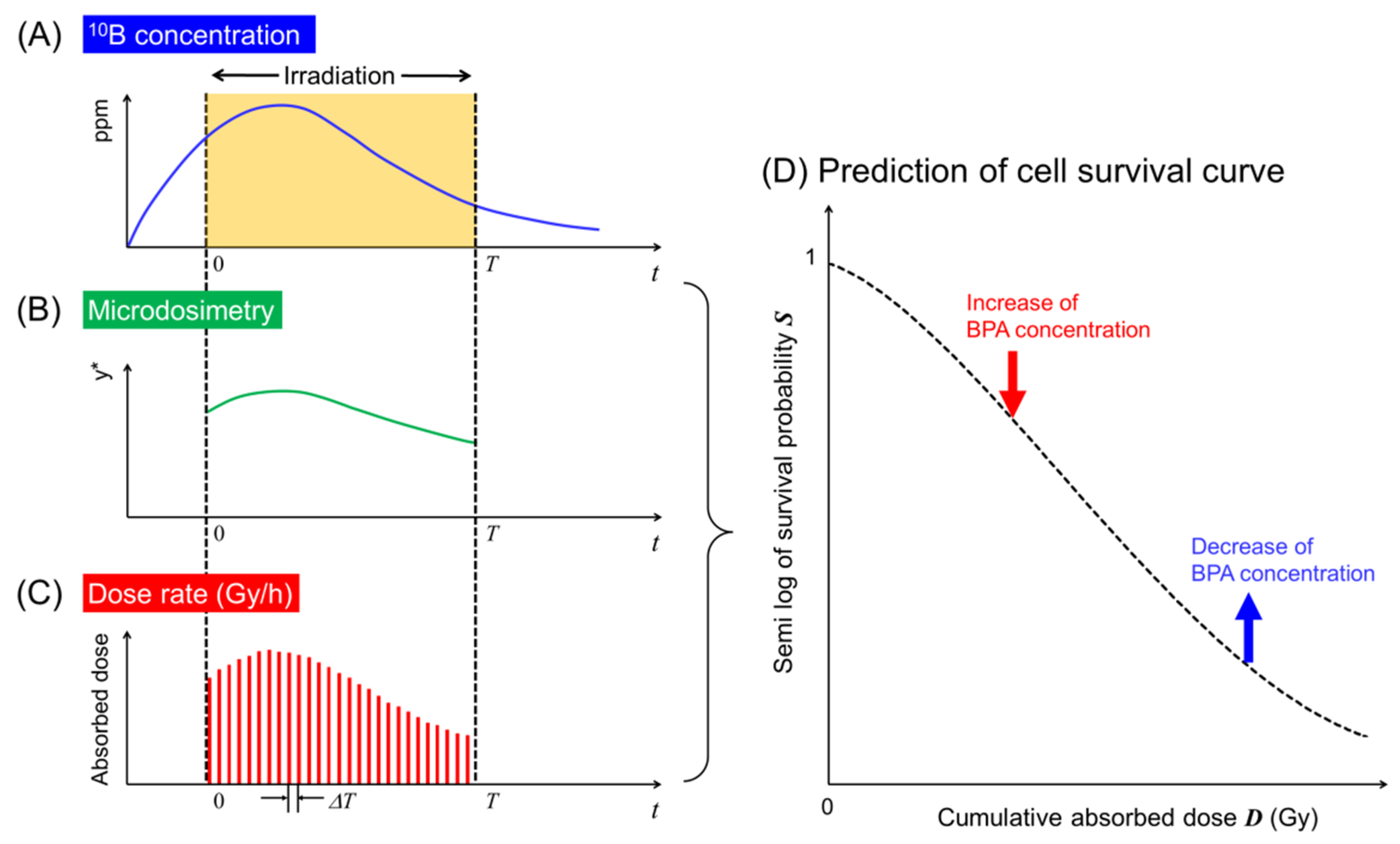
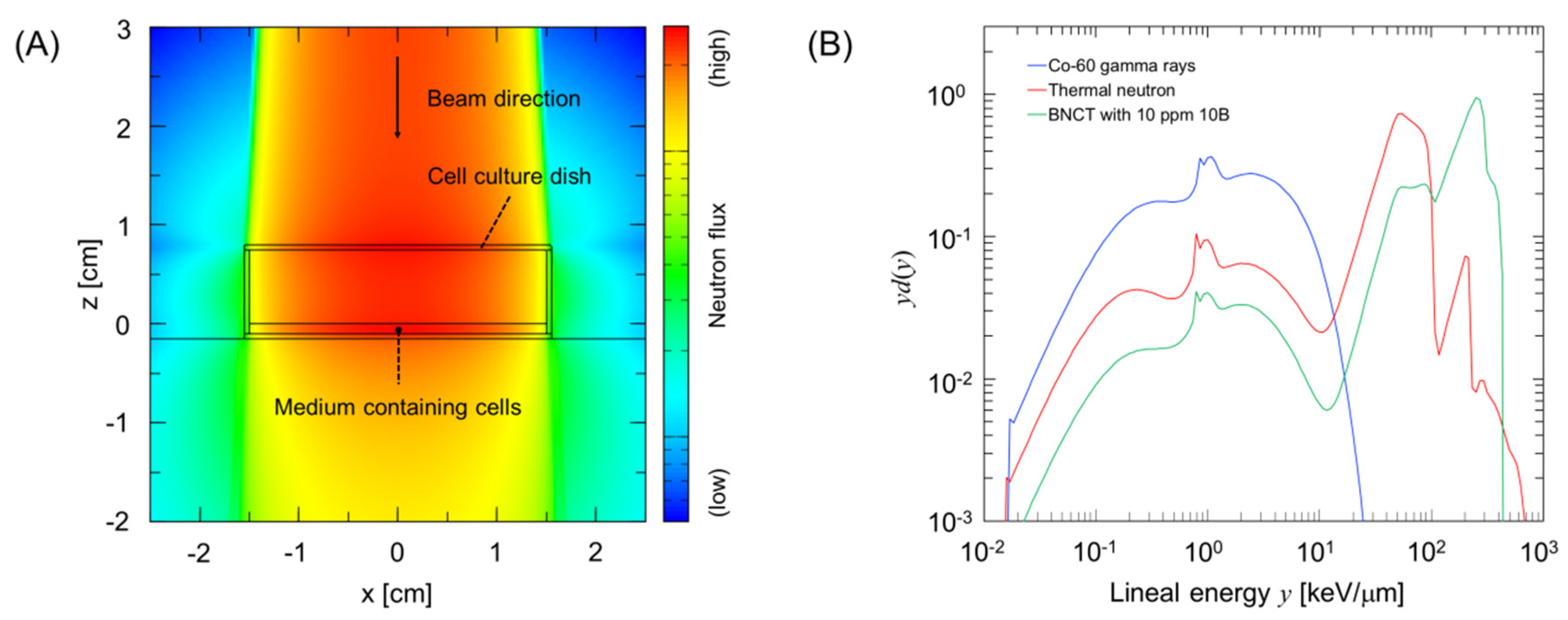

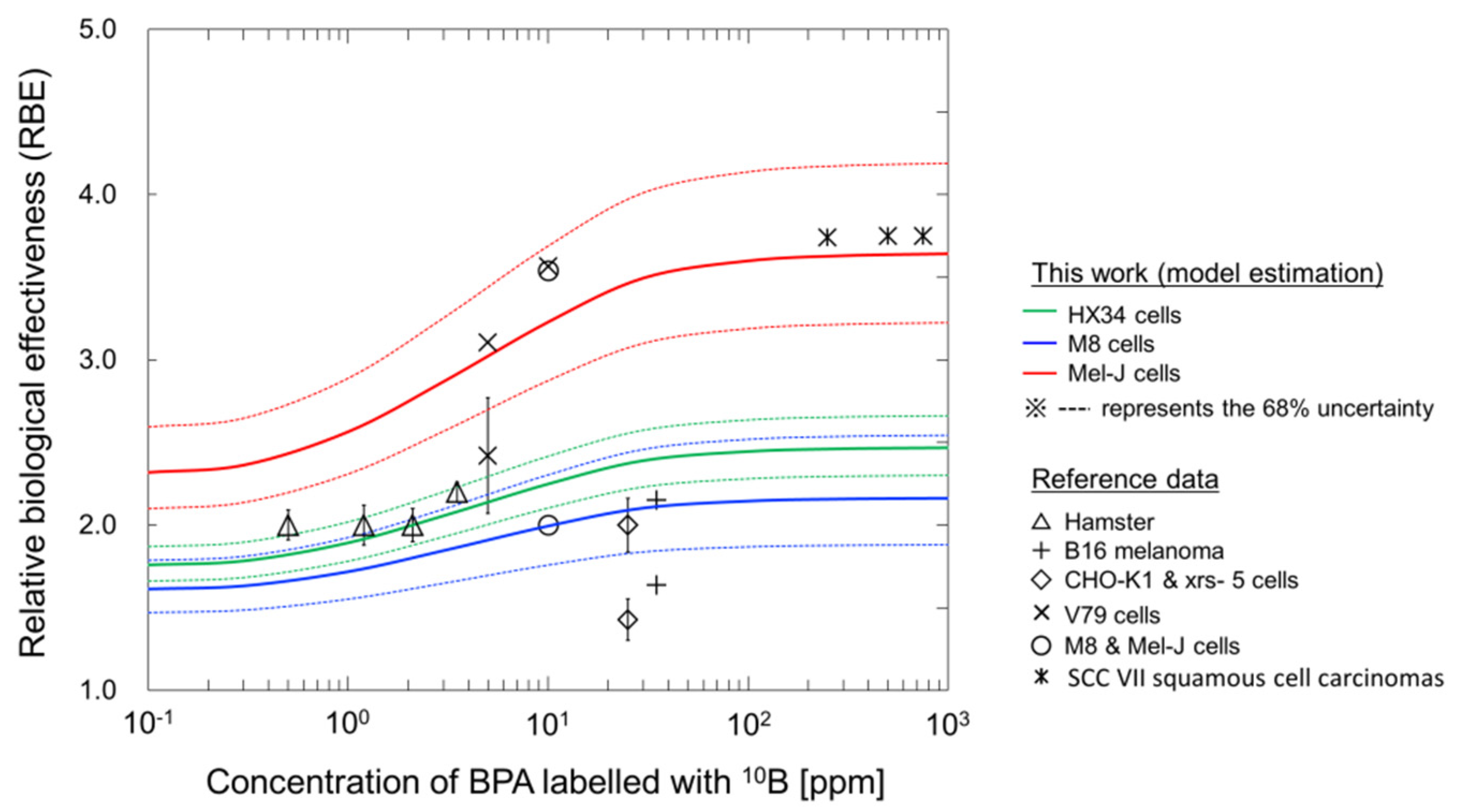
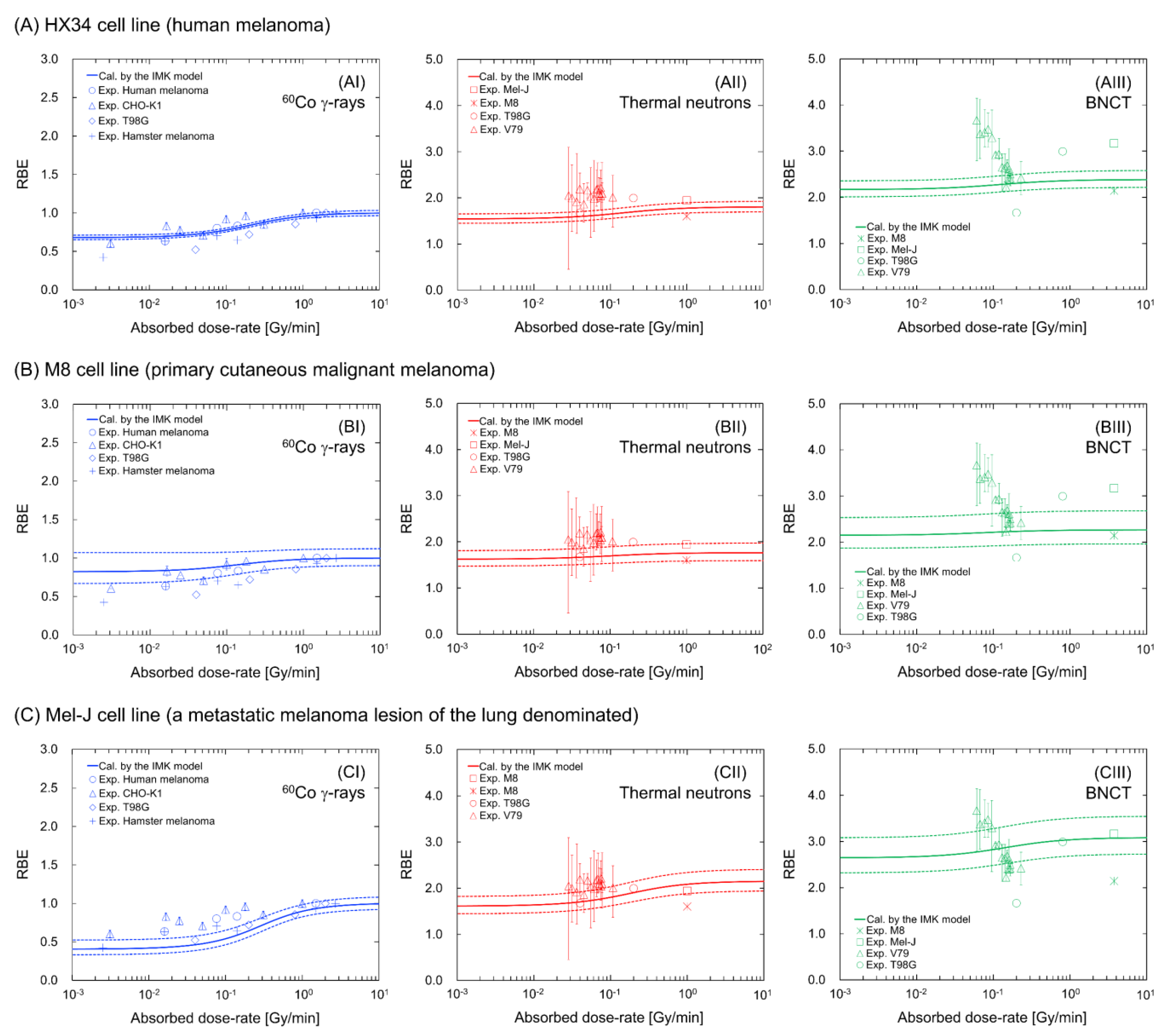

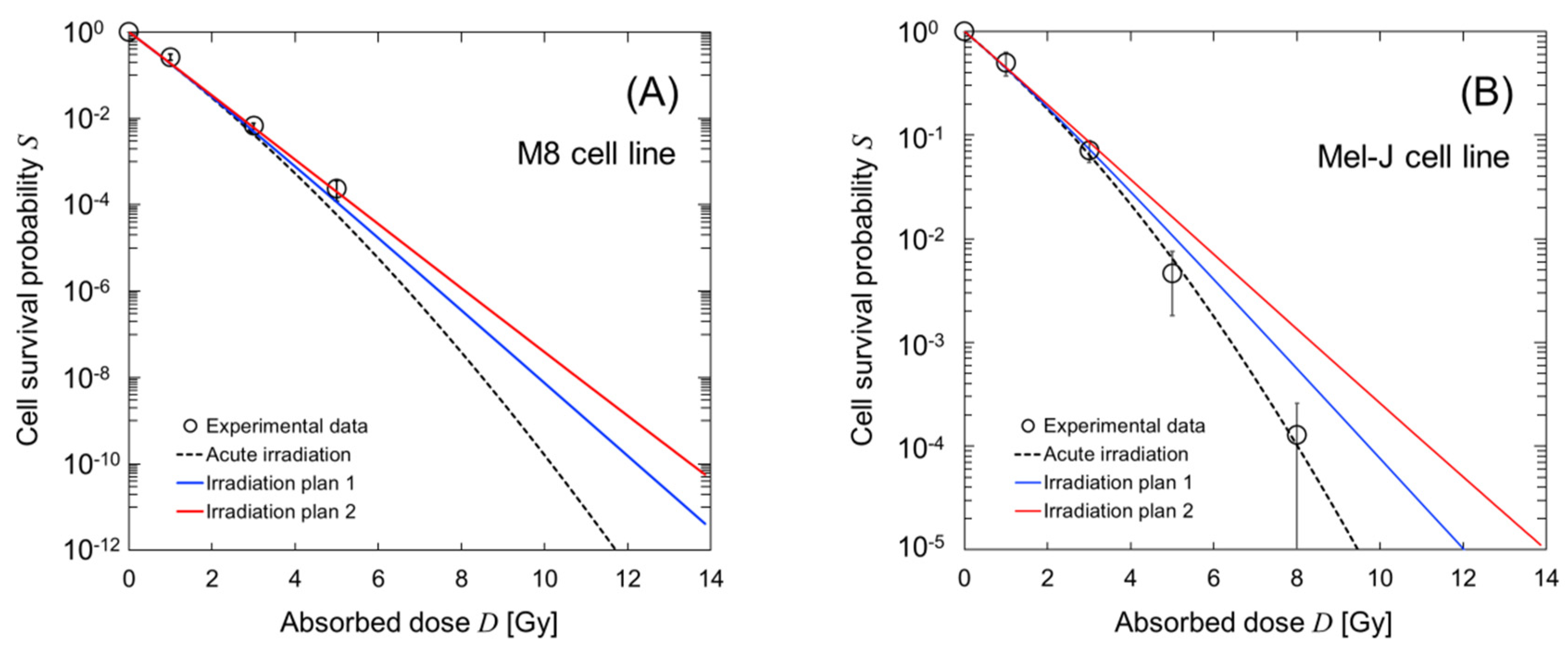
| Cell Line Type | Parameters | Values | Unit | How to Obtain the Parameter’s Values |
|---|---|---|---|---|
| HX34 cell line | α0 | 0.263 ± 0.016 | Gy−1 | MCMC with ref. [45] (60Co γ-ray data) |
| β0 | 0.047 ± 0.005 | Gy−2 | MCMC with ref. [45] (60Co γ-ray data) | |
| (a + c) | 8.857 ± 2.175 * | h−1 | MCMC with ref. [45] (60Co γ-ray data) | |
| M8 cell line (primary melanoma) | α0 | 0.612 ± 0.130 | Gy−1 | MCMC with ref. [39] (60Co γ-ray data) |
| β0 | 0.066 ± 0.020 | Gy−2 | MCMC with ref. [39] (60Co γ-ray data) | |
| (a + c) | 8.769 ± 2.128 | h−1 | Update with ref. [39] and the (a + c) value * | |
| Mel-J cell line (metastatic melanoma) | α0 | 0.002 ± 0.047 | Gy−1 | MCMC with ref. [39] (60Co γ-ray data) |
| β0 | 0.050 ± 0.009 | Gy−2 | MCMC with ref. [39] (60Co γ-ray data) | |
| (a + c) | 8.916 ± 2.126 | h−1 | Update with ref. [39] and the (a + c) value * |
© 2020 by the authors. Licensee MDPI, Basel, Switzerland. This article is an open access article distributed under the terms and conditions of the Creative Commons Attribution (CC BY) license (http://creativecommons.org/licenses/by/4.0/).
Share and Cite
Matsuya, Y.; Fukunaga, H.; Omura, M.; Date, H. A Model for Estimating Dose-Rate Effects on Cell-Killing of Human Melanoma after Boron Neutron Capture Therapy. Cells 2020, 9, 1117. https://doi.org/10.3390/cells9051117
Matsuya Y, Fukunaga H, Omura M, Date H. A Model for Estimating Dose-Rate Effects on Cell-Killing of Human Melanoma after Boron Neutron Capture Therapy. Cells. 2020; 9(5):1117. https://doi.org/10.3390/cells9051117
Chicago/Turabian StyleMatsuya, Yusuke, Hisanori Fukunaga, Motoko Omura, and Hiroyuki Date. 2020. "A Model for Estimating Dose-Rate Effects on Cell-Killing of Human Melanoma after Boron Neutron Capture Therapy" Cells 9, no. 5: 1117. https://doi.org/10.3390/cells9051117
APA StyleMatsuya, Y., Fukunaga, H., Omura, M., & Date, H. (2020). A Model for Estimating Dose-Rate Effects on Cell-Killing of Human Melanoma after Boron Neutron Capture Therapy. Cells, 9(5), 1117. https://doi.org/10.3390/cells9051117





